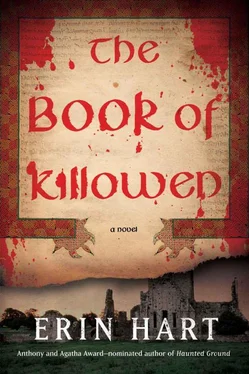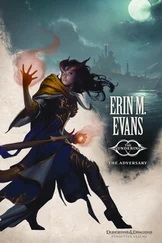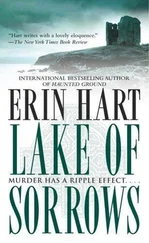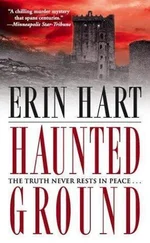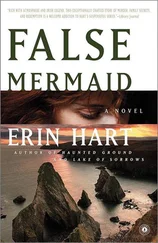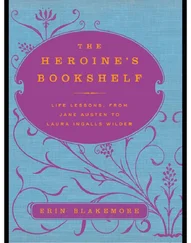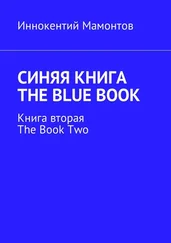Nora shot him an inquisitive glance, and Cormac understood exactly what she was asking. “Ancient Brehon law books,” he murmured.
With Mullens supervising, they each worked on a small area, lifting the wet wool with long, flat probes, holding it away from the bog man’s flesh, spritzing frequently. Trying to undress someone who’d been in a bog for centuries was delicate work. The body and the clothes were all dyed a uniform shade of dark brown, looking as if they’d been soaking for hundreds of years in a vat of Guinness.
“Early medieval construction didn’t vary a lot. Looks like a rather plain overgarment,” Mullens said, almost like a pathologist scrutinizing a corpse. “From the amount of material here, I’d say it was an ankle-length woolen brat —a basic cloak, no embroidery or special trim. You didn’t happen to find a brooch of any kind?”
“Not so far,” Dawson said. “Although the body had been moved from its original location. We’ll know more after we’re finished at the site. If that bollocks Claffey took it—”
Nora said, “Niall, isn’t it possible that the people who killed him also pinched his brooch?”
Regina Mullens looked up. “What’s that?”
“Maybe you noticed these cuts through his cloak,” Nora said, gently lifting the fabric to show her. “They correspond with stab wounds to his stomach and back.”
“But this fella’s murder can’t be the reason you’ve got a crime scene. He’s been dead for centuries.” Regina Mullens was trying to work out the details of their intrigue. “All right, all right, no more in that vein.” She kept working, her nose only inches from the brown corpse. “So no brooch, at least for the moment. But I would expect to see a girdle or belt of some sort. Belting a cloak like this was fairly common—the draped material made handy pouches that medieval travelers used to carry things. Ah, here we are.”
Nora said, “We were wondering, given the bald patch and the stains on his hands, if perhaps he was a monk or a scribe.”
Mullens nodded and handed her the magnifying glass. “Well, you can take a look for yourself, but I’d say he came by that naked pate quite naturally. If you notice, the hairs on top of his head are very soft and fine, not like they’ve been shaved. Irish monks wore a distinctive tonsure.” She gestured, as if to pull a gloved thumb across her skull. “The whole front of the head shaved from ear to ear, with longer hair in back.”
Nora said, “You’d think he’d be wearing something under this wool.”
Mullens looked up. “Well, undergarments as we know them didn’t really exist until much later. But supposing he had gone into the bog fully dressed in the fashion for his time, he’d likely have been wearing a leine , a sort of linen shift, under his brat . But linen’s rather delicate. Doesn’t usually survive, even in a bog.” She paused, feeling through the wool. “There seems to be something underneath him here. I don’t suppose we could try turning him over?”
After about twenty minutes, they’d managed to flip the body, and Regina Mullens had peeled away enough of the woolen material to find what had been hiding inside Killowen Man’s cloak. “I’m dying to know what this is,” she said.
The object looked like some sort of diptych: two flat, rectangular pieces of wood, about the size and shape of a small paperback. Cormac could make out two holes drilled along one of the longer edges, looped through with a leather thong.
“Bloody hell, we were just talking about these last night,” Dawson said. He reached in very gingerly and lifted one of the pieces of saturated, bog-preserved wood. The thing opened quite easily on its leather hinge, revealing two reservoirs of darkened wax, scratched with words in an ancient script. “Looks like Latin,” he murmured. “And a few words in Greek. My God, there’s been nothing like this since Springmount.”
Nora moved in closer, crowding in with the rest of them. “What’s Springmount? Will someone please explain?”
Cormac spoke without turning his head from the object on the table, as if it might disappear if he looked away. “A set of seventh-century wax tablets discovered at Springmount Bog in Antrim in 1914.”
“And there was writing on those as well?” Nora asked.
“A couple of verses from the Vulgate text of Psalms.” Dawson shook himself, glancing between the body and the wooden object on the table. “I still don’t quite believe it. You realize we have not just a tablet—pretty miraculous in and of itself—but we may also have the person who wrote it. ” Dawson’s voice trembled with excitement. “See how the passage fills the panel on the left side? And the right side is incomplete—”
“A work in progress?” Cormac wondered aloud.
Dawson rubbed his forehead, still not able to take it all in.
“What happens now?” Mullens asked.
“We carry on here with our cameras and spray bottles,” Niall Dawson said. “We take as many notes and pictures as possible, then pack everything back up in peat and keep working out at the site. And I suppose we’ll have to go and talk to Vincent Claffey.”
Cormac’s eyes were drawn to a pair of marble-shaped objects nestled in a fold of wool beside the body. “Did you see these, Niall?” He managed to tease one of them out of the crevice and handed it to Dawson.
“Hmm… they look like oak galls.”
“For making ink,” Nora murmured.
“That’s right,” Dawson replied. “How did you know that?”
Something wasn’t right. Nora looked as if someone had walked on her grave. Cormac moved closer. “What’s wrong, Nora?”
“I don’t know. Just a weird coincidence, I guess. Dr. Friel and I found a handful of those yesterday—forced down Benedict Kavanagh’s throat.”
Stella and Fergal Molloy were working on an incident wall in their tiny office at the back of the Birr police station. On the wall so far were Benedict Kavanagh’s photograph, a map of Ireland, and a fairly sparse time line marking the victim’s movements the last few days of his life. They had tracked down dates from credit card records in Kavanagh’s missing person file: he’d stopped for petrol at the Topaz on Donnybrook Road near the RTÉ studios, and then vanished.
“So the first question is: Would he come straight out to this place from Donnybrook, not even go home first? Maybe he finds out what the wife and her boy toy are up to and tracks her out here,” Molloy said.
“He seemed to have no problem with Graham Healy,” Stella said. “Knew all about the two of them, according to his wife. And Mairéad Broome wasn’t even here at the time—she and Healy claim they were in Mountrath.”
Molloy traced the distance from Killowen across the Slieve Bloom Mountains to Mountrath. “It’s only about forty kilometers. Do we believe them?”
“I’m not sure. If they’re lying about it, so is everyone else at Killowen.”
“Well, so maybe they are. Kavanagh could have been lurking about, spying on the wife. Suppose he confronted her and Healy, and there was an altercation. I think the motive was personal, not professional,” Molloy said. “Look at the way the body was left, with split tongue and those seeds or whatever they are in his mouth.”
“Dr. Gavin identified them, for what it’s worth—oak galls. Said she saw a whole load of them yesterday afternoon in Martin Gwynne’s studio. Any joy from Central Records?”
“Still waiting on most of my queries, but they were able to give me a rundown on Martin Gwynne.” He flipped open his notebook. “Studied medieval history at Cambridge, worked as a manuscript specialist for the British Library for fifteen years, until—get this—he was let go over a missing book. He claimed he was innocent; they declined to prosecute. It was never really resolved to anyone’s satisfaction. After that, he worked as a private assistant to his old tutor from Cambridge, the paleographer T. A. Priest, until Priest died, which was nineteen years ago. Gwynne and his wife arrived at Killowen not long after that.”
Читать дальше
